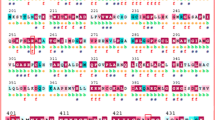Abstract
To characterize an Egyptian patient with glutaric acidemia type I (GA I) and to identify the causative mutation(s) that may be responsible for the disease phenotype. MRI was performed on the patient using the 1.5 T magnet, biochemical analysis was carried out using gas chromatography/mass spectrometry on the patient’s dried blood spot, and the patient’s organic acids were measured in dried blood and a urine sample using MS/MS and GC/MS, respectively. Total RNA was isolated from the patient’s peripheral blood, and the synthesized cDNA was bi-directionally sequenced. The patient exhibited clinical features and MRI findings compatible with a diagnosis of GA I. The abnormal elevation of organic acids in the urine supported the presence of glutaryl-CoA dehydrogenase deficiency. Gene sequencing revealed a novel homozygous frameshift mutation, c.644_645insCTCG; p.(Pro217Leufs*14), in exon 8 of the GCDH gene. The present study revealed a novel frameshift mutation responsible for a severe GA I phenotype in an Egyptian patient. This novel mutation will ultimately contribute to a better understanding of the molecular pathology of the disease and shed light on the intricacies of the genotype-phenotype correlation of GA I disease.



Similar content being viewed by others
References
Baric I, Wagner L, Feyh P, Liesert M, Buckel W, Hoffmann GF (1999) Sensitivity and specificity of free and total glutaric acid and 3-hydroxyglutaric acid measurements by stable-isotope dilution assays for the diagnosis of glutaric aciduria type I J Inherit Metab Dis 22:867–881
Baric I et al. (1998) Diagnosis and management of glutaric aciduria type I J Inherit Metab Dis 21:326–340
Biery BJ, Stein DE, Morton DH, Goodman SI (1996) Gene structure and mutations of glutaryl-coenzyme A dehydrogenase: impaired association of enzyme subunits that is due to an A421 V substitution causes glutaric acidemia type I in the Amish American J Hum Genet 59:1006–1011
Bijarnia S, Wiley V, Carpenter K, Christodoulou J, Ellaway CJ, Wilcken B (2008) Glutaric aciduria type I: outcome following detection by newborn screening. J Inherit Metab Dis 31:503–507. doi:10.1007/s10545-008-0912-z
Boneh A, Beauchamp M, Humphrey M, Watkins J, Peters H, Yaplito-Lee J (2008) Newborn screening for glutaric aciduria type I in Victoria: treatment and outcome. Mol Genet Metab 94:287–291. doi:10.1016/j.ymgme.2008.03.005
Busquets C et al. (2000) Glutaryl-CoA dehydrogenase deficiency in Spain: evidence of two groups of patients, genetically, and biochemically distinct. Pediatr Res 48:315–322. doi:10.1203/00006450-200009000-00009
Chace DH, Kalas TA, Naylor EW (2003) Use of tandem mass spectrometry for multianalyte screening of dried blood specimens from newborns. Clin Chem 49:1797–1817
Christensen E, Ribes A, Merinero B, Zschocke J (2004) Correlation of genotype and phenotype in glutaryl-CoA dehydrogenase deficiency. J Inherit Metab Dis 27:861–868. doi:10.1023/B:BOLI.0000045770.93429.3c
Greenberg CR et al. (2002) Outcome of the first 3-years of a DNA-based neonatal screening program for glutaric acidemia type 1 in Manitoba and northwestern Ontario, Canada. Mol Genet Metab 75:70–78. doi:10.1006/mgme.2001.3270
Gregersen N, Brandt NJ, Christensen E, Gron I, Rasmussen K, Brandt S (1977) Glutaric aciduria: clinical and laboratory findings in two brothers. J Pediatr 90:740–745
Gupta N et al. (2015) Glutaric Acidemia Type 1-Clinico-Molecular Profile and Novel Mutations in GCDH Gene in Indian Patients. JIMD reports 21:45–55. doi:10.1007/8904_2014_377
Heringer J et al. (2010) Use of guidelines improves the neurological outcome in glutaric aciduria type I. Ann Neurol 68:743–752. doi:10.1002/ana.22095
Hoffmann GF et al. (1991) Glutaryl-coenzyme A dehydrogenase deficiency: a distinct encephalopathy. Pediatrics 88:1194–1203
Kolker S et al. (2007a) Guideline for the diagnosis and management of glutaryl-CoA dehydrogenase deficiency (glutaric aciduria type I). J Inherit Metab Dis 30:5–22. doi:10.1007/s10545-006-0451-4
Kolker S et al. (2007b) Decline of acute encephalopathic crises in children with glutaryl-CoA dehydrogenase deficiency identified by newborn screening in Germany. Pediatr Res 62:357–363. doi:10.1203/PDR.0b013e318137a124
Kolker S et al. (2006) Nat Hist, outcome, and treatment efficacy in children and adults with glutaryl-CoA dehydrogenase deficiency. Pediatr Res 59:840–847. doi:10.1203/01.pdr.0000219387.79887.86
Lindner M, Kolker S, Schulze A, Christensen E, Greenberg CR, Hoffmann GF (2004) Neonatal screening for glutaryl-CoA dehydrogenase deficiency. J Inherit Metab Dis 27:851–859. doi:10.1023/B:BOLI.0000045769.96657.af
Mohammad SA, Abdelkhalek HS, Ahmed KA, Zaki OK (2015) Glutaric aciduria type 1: neuroimaging features with clinical correlation. Pediatr Radiol 45:1696–1705. doi:10.1007/s00247-015-3395-8
Mushimoto Y et al. (2011) Clinical and molecular investigation of 19 Japanese cases of glutaric acidemia type 1. Mol Genet Metab 102:343–348. doi:10.1016/j.ymgme.2010.11.159
Scriver C, Sly W, Childs B, Beaudet A, Valle D, Kinzler K, Vogelstein B (2000) The metabolic and molecular bases of inherited disease vol 4. 8th edn. McGraw-Hill Professional,
Strauss KA, Puffenberger EG, Robinson DL, Morton DH (2003) Type I glutaric aciduria, part 1: natural history of 77 patients American journal of medical genetics Part C. Seminars in medical genetics 121c:38–52. doi:10.1002/ajmg.c.20007
Tadmouri GO, Nair P, Obeid T, Al Ali MT, Al Khaja N, Hamamy HA (2009) Consanguinity and reproductive health among Arabs Reprod Health 6:17 doi:10.1186/1742-4755-6-17
Twomey EL, Naughten ER, Donoghue VB, Ryan S (2003) Neuroimaging findings in glutaric aciduria type 1. Pediatr Radiol 33:823–830. doi:10.1007/s00247-003-0956-z
Author information
Authors and Affiliations
Corresponding authors
Ethics declarations
Conflict of interest statement
All authors declare that they have no conflicts of interest.
Rights and permissions
About this article
Cite this article
Moseilhy, A., Hassan, M.M., El Abd, H.S.A. et al. Severe neurological manifestations in an Egyptian patient with a novel frameshift mutation in the Glutaryl-CoA dehydrogenase gene. Metab Brain Dis 32, 35–40 (2017). https://doi.org/10.1007/s11011-016-9879-x
Received:
Accepted:
Published:
Issue Date:
DOI: https://doi.org/10.1007/s11011-016-9879-x




